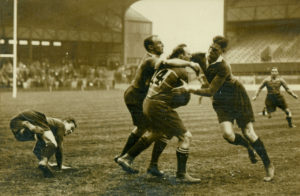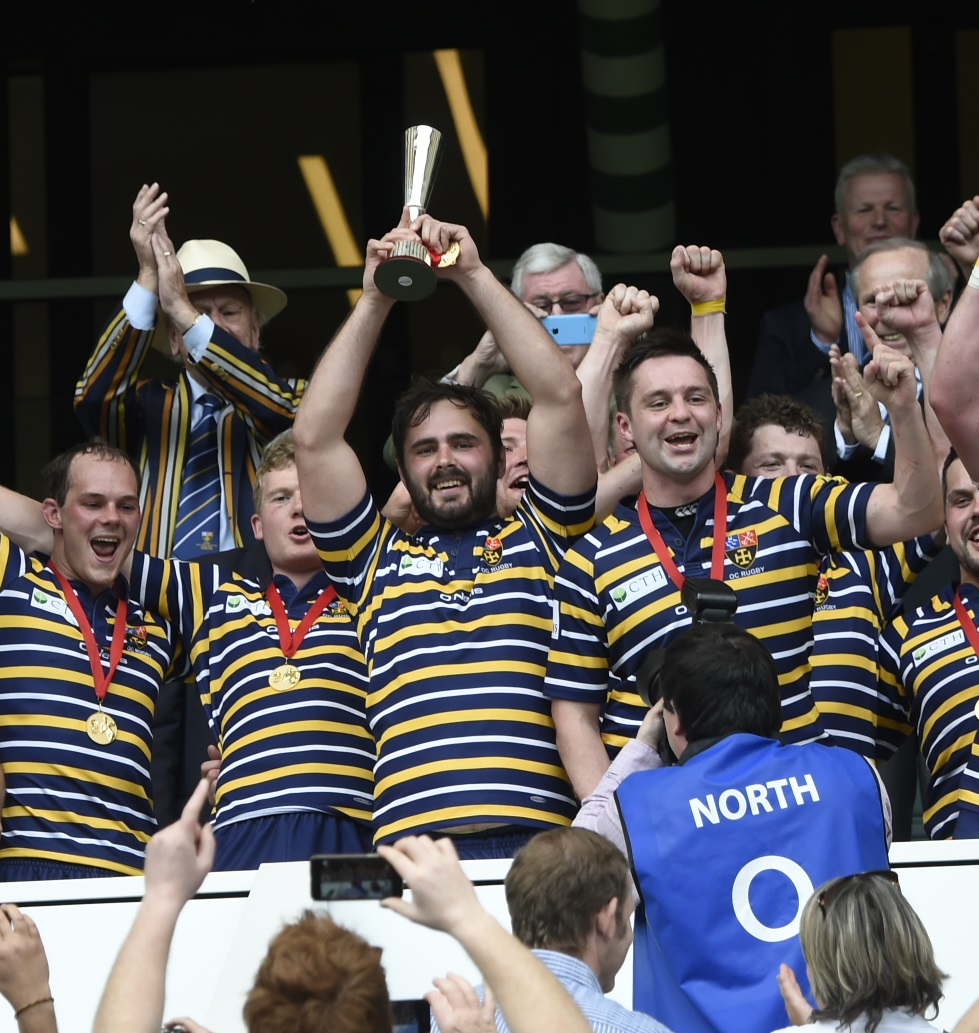
Adapted from Mike Fawcett’s book on the history of the game at Cranleigh School and the Club – see end of article for purchasing details
Rugby football replaced the round ball as the major winter sport at Cranleigh in the Lent Term 1916, coached by a young man named Charles Gower, who had joined the staff that term. It was an event which was to have a profound effect on the School’s whole future.
Gower, ‘the Architect of Cranleigh Rugger’ as inscribed on outdoor spectator benches donated to the School by the OCs at a later date in his memory, was a tyrant of a coach, but his unceasing keenness and enthusiasm soon spread to his pupils. “His creed was quite straightforward”, said H P Jacob (‘Jake’, himself a legendary Oxford and England wing three-quarter). “Simple things well done and at speed. The perfect giving and taking of passes, incessant backing up, and relentless pressure.”
Success soon followed this regime, blossoming hugely after the War, with substantial victories over all the schools on the circuit and beyond, as the fame of Cranleigh rugby spread through the land. The oval ball was increasingly worshiped to a degree that would not be acceptable today, but there is little doubt that this prowess did no harm at all to the School, with fond parents desperate to get their sons into Cranleigh. The highest score recorded in the outstanding 1920-21 season was 136-0 over KCS Wimbledon, who had not previously lost a match that year (20 goals, 12 tries – remember, only 3 points for a try then), with some famous names beginning to emerge. M S Bonaventura and Jacob went on to England caps, while Leonard Leroy, said by Jacob to have been perhaps the most gifted footballer of them all, went to Canada, where he played for the national side.
1919 – 1939
The end of the War also saw the end of the OC Football Club, which gave way to the OCRFC formed in 1919. After a few years’ nomadic existence, a ground was found at Wembley under a 5 years lease from 1923, but this was not a very satisfactory venue, often waterlogged and in a difficult location. Then after an extended search, the Thames Ditton ground was found at last in 1928. The freehold was purchased, after much negotiation, for £2500 and the clubhouse built for a similar sum, funded by a transfer from the OC Society Life Membership Fund, an RFU loan repayable over 15 years, and substantial pledges from individual OCs. “Success is not in wins and losses, but in the manner of upholding the spirit and sportsmanship of the game”, said the President of the Rugby Union in formally opening the ground on 24 November 1928 with a match against Old Blues (won 5-3).
The next decade was the epoch of old boys rugby, and the OCRFC was at the forefront of that. In 1935 the club was able to put out a side made almost entirely of internationals and county players. In 1929 the OCRFC charged for a season ticket to matches at TD (OCs were given a free pass) but the strength of the fixture list warranted that opponents included Neath, Maesteg, London Welsh and London Scottish. In 1931-32 the club reached the semi-finals of the Middlesex Sevens where they led Harlequins when they lost JE Benyon through injury; six against seven was too much of a handicap and they lost in extra time. They again reached the semis the following season, defeated on that occasion by Wasps.
In this period, the OCRFC got extensive media coverage and was visited by national selectors. By the mid 1930s the fixture list included Gloucester, Wasps, Swansea, Sale, Bath and London Welsh, and in 1935 a grandstand, accommodating 180 persons and costing £446 was built. The club also had depth, with four regular sides turning out each week.
Alan Key, who captained the club, played for England, Stanley Couchman and FJ Reynolds (who also played for England) toured South Africa with the British Lions (Cyril Suter was also picked but was unable to go). C O’N Wallis represented Ireland, and finally in 1938-39 Bob Carr won his two England caps.

1946 – 1959
Two half-hearted attempts were made to raise sides in the early days of the war, but too many players were in service. At the end of the war, it was clear that TD was not available for use; it had been requisitioned by the War Office and needed ploughing up and relaying. The club restarted in 1945-46, based down the road at Old Paulines, but the world had moved on and old boys rugby was not nearly the force it was. The OCRFC was no exception.
The club was back at TD in 1946-47, with the first post-war match again against the Old Blues, but the pre-war fixture list soon had to be trimmed to reflect the changing state of play. The 1950s were a period where the club remained strong, even if standards were no longer as high. The Cranleighan in 1952-53 noted that it was hard recruiting players and pondered whether ‘the difficulties hindering an old boys club in these days are not so great as to make a revival not on.’ The remarkable performance of the School in 1955-56, when they won 11 in 11, gave the whole club a fillip, and many of that side went on to play for the OCs.
By the following season, the club was again looking to strengthen the fixture list, and in 1957-58 a high-profile match at Moseley seemed doomed when a derailment at Paddington closed the rail network, but the team rushed to Croydon airport and flew to the midlands. The extravagance was rewarded with a 3-3 draw.
In 1958-59, Jeff Clements, who had remained loyal to the OCRFC, and was captaining them despite warnings that it would hamper his international ambitions, was rewarded with his England call-up. Bob Taylor, the OCs stand-in captain at US Portsmouth took great delight in apologising to his opposite number for the skipper’s absence, casually explaining he was “playing for England this afternoon”. That period was to prove the last great period in the club’s history.
1960 – 1979
The 1960s were a period of slow decline, as the side which had done so well in the previous decade aged. There were still up to five sides fielded, but the quality was in decline. In 1964-65, the 1st XV suffered 21 successive defeats. A brief revival under the charismatic David Bluett in the mid 60s did not last. In 1967-68 the unthinkable was suggested – that the club allow non-OCs to play to try to maintain standards. EW Swanton, who had acted as secretary and unashamed publicist for the club for many years, even investigated a merge with Old Millhillians: “Better to keep the club strong without going outside old boys” – but the idea never took root. Almost a decade later a merge with the Old Blues was discussed.
The struggle to recruit players exclusively from the School was becoming almost impossible by the mid 1970s, and in 1977-78 the club was officially declared open (a few non-OCs had been quietly playing for some time in the lower sides) and David Guest, a non-OC, was elected Club Captain. But the slow decline continued and it became an increasing battle to keep the flag flying.
1980 – 1990
That downslide was checked by the appointment of Julian Tompkins in 1983-84, and the benchmark was set by nine wins in his first 11 matches. The season culminated in a 6-4 win over Old Blues, and 22 of 34 matches were won. David Bugge led the charge with 191 points while Henry Corp scored 15 tries. The B XV were also successful, winning 18 out of 23. But the number of OCs in sides was steadily falling.
In 1984-85, the season finale against the Old Blues was also the Merit Table decider and 400 spectators packed the touchlines to watch a late David Cardwell try secure a 13-7 win. It was the club’s first and only Merit Table success. All four sides won more matches than they lost. But many of the core of that side soon departed, and by 1987-88 the 1st XV lost 25 of their 30 matches.
1991 onward
The era of the increasing professionalisation of the game and a differing approach to way it was played meant that rugby clubs all over the country felt the pinch and many folded. That the OCRFC did not is a credit to those involved in its running and the financial support of Andrew Cronk helped the club through some tough times. A fire at the club had a positive long-term effect, and a rebuilt clubhouse meant that the hockey club inherited the prime pitch and grandstand, and the rugby pitches were moved to the far end of the land. In 1993-94 the OCs won Surrey Division Two, winning 20 of the 27 matches.
This is just an introduction to the OCRFC. Those who would like to read more of the heroic achievements of the Club, with wins over many of the most famous sides in the land, the International caps won, the sequestration of the ground as a Civil Defence training centre during WW2, the ups and downs after the War, through to the present day in Surrey League 1, should purchase a copy of A History of the Old Cranleighan Rugby Football Club [“Every rugger-minded OC should buy Mike Fawcett’s wonderfully detailed, painstaking, stirring story of the OCRFC” – E W Swanton. “. . . an essential blueprint for anybody contemplating a similar history of their club” ? Daily Telegraph].